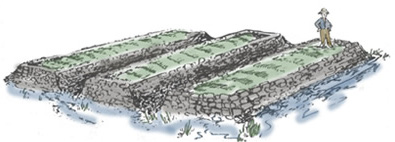
Central American raised beds
 Another familiar concept --- the raised
bed --- is very widespread in Central American farming. Unlike
the fancy raised beds many Americans make with walls of wood or stone,
Central American raised beds look an awful lot like our
low cost garden beds. The beds are simply mounds of earth of
varying heights and sizes and with various purposes.
Another familiar concept --- the raised
bed --- is very widespread in Central American farming. Unlike
the fancy raised beds many Americans make with walls of wood or stone,
Central American raised beds look an awful lot like our
low cost garden beds. The beds are simply mounds of earth of
varying heights and sizes and with various purposes.
The most familiar to me are camellones
(like the ones shown above), which average about 5 feet wide and a foot
high by many feet long. Camellones provide loose earth for easy
planting and root development, improve drainage and lift plants above
flood or irrigation water, retain moisture on slopes, and make it easy
to control weeds and mix in soil amendments. This type of raised
bed is typically used for maize and other vegetable crops, although
taller mounds are often created for planting mango trees in flooded
areas.
Even more widespread are
mules, a type of raised bed
created by hilling up soil around young maize plants. The process
is reported to be very labor intensive and reminds me of hilling
potatoes. The mules are important in windy
areas, where they keep the maize plants from blowing over, and mules everywhere seem to improve
drainage and aeration, decrease evaporation, and control weeds.
Oddly, modern farmers don't think that mules are worth the effort, but
some continue to hill up mounds of earth around the perimeters of their
fields to serve as a sort of windbreak.
| This post is part of our Central American Permaculture lunchtime
series.
Read all of the entries: |
Want more in-depth information? Browse through our books.
Or explore more posts by date or by subject.
About us: Anna Hess and Mark Hamilton spent over a decade living self-sufficiently in the mountains of Virginia before moving north to start over from scratch in the foothills of Ohio. They've experimented with permaculture, no-till gardening, trailersteading, home-based microbusinesses and much more, writing about their adventures in both blogs and books.
Want to be notified when new comments are posted on this page? Click on the RSS button after you add a comment to subscribe to the comment feed, or simply check the box beside "email replies to me" while writing your comment.
